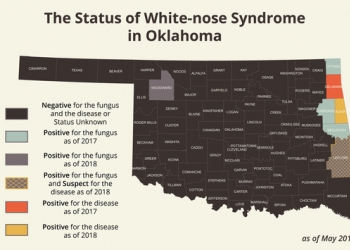News
State of Oklahoma
Posted: May 11, 2018 12:55 PMUpdated: May 11, 2018 12:55 PM
Bat Fungus Found In Oklahoma

Surveillance for white-nose syndrome and the fungus that causes the bat disease found that bats in seven Oklahoma counties have been infected. The fungus, Pseudogymnoascus destructans, was first detected in New York and had spread to Oklahoma by the winter of 2014–2015.
Bats play an important ecological role; each bat can eat up to 3,000 insects, including mosquitoes and agricultural pests, in a single night. Biologists are concerned how white-nose syndrome will affect Oklahoma bat populations in the future.
White-nose syndrome is named for the white fungal growth often observed around the nose of infected bats. This fungal growth on the muzzles and wings of hibernating bats is suspected to irritate the bats, waking them when food resources, namely insects, are minimal. The wakened bats may not be able to find enough food to survive the winter. There are no known human health implications associated with white-nose syndrome.
Partners in Oklahoma bat conservation swabbed more than 200 bats in 12 limestone caves and six gypsum caves during this year’s bat disease surveillance efforts. The bulk of samples were sent for analysis to the USGS National Wildlife Health Center in Madison, Wisconsin.

« Back to News













